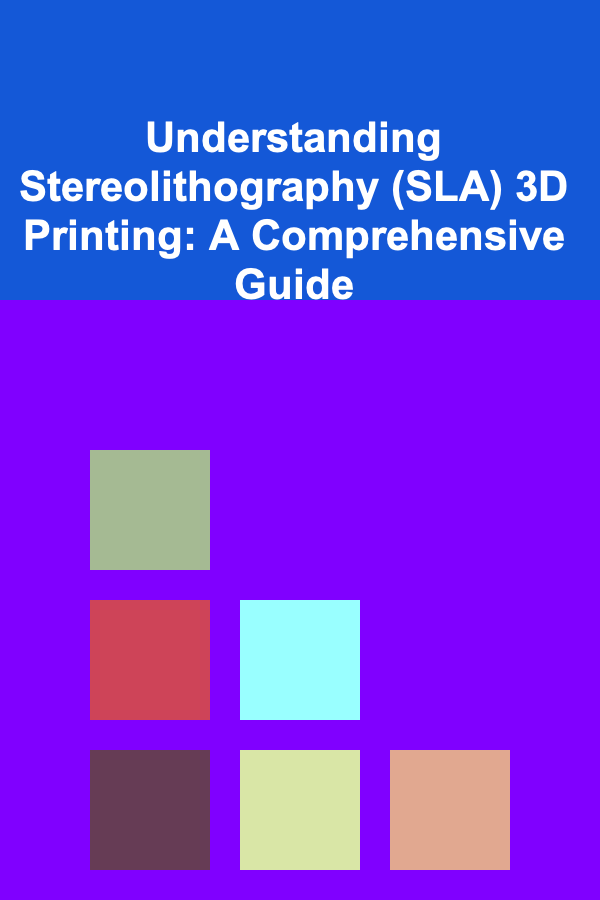
Understanding Stereolithography (SLA) 3D Printing: A Comprehensive Guide
ebook include PDF & Audio bundle (Micro Guide)
$12.99$7.99
Limited Time Offer! Order within the next:

Stereolithography (SLA) stands as one of the foundational technologies within the expansive landscape of 3D printing. Introduced in the early 1980s by Chuck Hull, it was the very first 3D printing process patented, setting the stage for the additive manufacturing revolution we witness today. While newer technologies have emerged, SLA continues to be a prominent and valuable tool for creating high-resolution, intricate parts with excellent surface finishes. This comprehensive guide dives deep into the workings of SLA, its advantages and disadvantages, the materials it utilizes, its applications, and future trends.
The Fundamentals of SLA: How It Works
At its core, SLA leverages the power of photopolymerization, a process where liquid resins are cured, or solidified, by exposure to specific wavelengths of light. This process is executed layer by layer, building a three-dimensional object from the ground up. The essential components of an SLA printer include:
- A Vat of Liquid Resin: This tank holds the photopolymer resin, a light-sensitive liquid material that will be solidified to form the printed object.
- A Light Source: Traditionally, this was a UV laser. Modern SLA printers also use digital light processing (DLP) with a projector. The light source is responsible for selectively curing the resin.
- A Build Platform: This platform is submerged in the resin vat and moves vertically, allowing each layer to be printed and then lowered for the next.
- A Computer and Software: The computer controls the entire process, from slicing the 3D model into thin layers to directing the light source and managing the build platform. Specialized software is used to design supports and prepare the model for printing.
The SLA printing process unfolds as follows:
- Model Preparation: The 3D model is first designed using CAD (Computer-Aided Design) software. This model is then imported into slicing software. The slicer divides the 3D model into hundreds or even thousands of thin, two-dimensional cross-sections (layers). The software also generates support structures, if needed, to hold overhanging parts of the model during printing.
- Layer Curing: The build platform is lowered into the resin vat until it is just slightly above the bottom. The light source (laser or projector) then selectively cures the first layer of resin, solidifying it onto the build platform. The light source follows the precise path dictated by the sliced data, tracing the outline of the layer and then filling in the interior.
- Platform Movement: After the first layer is cured, the build platform moves upward (or downward in some designs) a small distance, typically a fraction of a millimeter, to create space for the next layer of resin. A sweeper blade might then move across the resin vat to ensure a fresh, even layer of liquid resin is ready for curing.
- Repeat and Build: Steps 2 and 3 are repeated layer by layer until the entire object is printed. Each layer adheres to the layer below it, gradually building up the three-dimensional structure.
- Post-Processing: Once the printing is complete, the build platform is raised out of the resin vat. The printed object is then removed from the platform. Post-processing typically involves removing the support structures, washing the object to remove any uncured resin, and often a final curing step under UV light to fully solidify the part and enhance its mechanical properties.
There are two main variations of SLA technology:
- Laser-Based SLA: This original form of SLA uses a UV laser to trace out each layer. The laser beam is directed by mirrors, allowing it to precisely cure the resin. Laser-based SLA offers high precision and is capable of producing parts with very fine details.
- DLP (Digital Light Processing) SLA: DLP SLA uses a projector to cure an entire layer at once. The projector shines a digital image of the layer onto the resin, solidifying the entire cross-section in a single flash. DLP is generally faster than laser-based SLA, especially for parts with large cross-sectional areas, but it may sometimes sacrifice some precision compared to laser-based systems. MSLA (Masked Stereolithography Apparatus) is a subcategory of DLP that uses an LCD screen as a mask to selectively block light, creating an image of the layer to be cured. MSLA printers are generally more affordable than traditional DLP printers.
Advantages of SLA Printing
SLA 3D printing offers a compelling set of advantages that make it a popular choice for various applications:
- High Resolution and Accuracy: SLA excels at producing parts with very fine details and smooth surface finishes. The precise control of the light source allows for the creation of intricate geometries with high accuracy. This makes SLA ideal for applications requiring tight tolerances and aesthetic appeal.
- Smooth Surface Finish: Compared to other 3D printing technologies like FDM (Fused Deposition Modeling), SLA produces parts with a significantly smoother surface finish. The layer lines are much less pronounced, reducing the need for extensive post-processing.
- Complex Geometries: SLA can handle complex geometries, including intricate internal structures and delicate features. The support structures generated by the slicing software provide the necessary support during printing, allowing for the creation of designs that would be difficult or impossible to manufacture using traditional methods.
- Wide Range of Materials: While the material selection for SLA is not as vast as some other 3D printing technologies, there is a growing range of photopolymer resins available with varying properties. These resins can be formulated to mimic the characteristics of different engineering plastics, offering options for strength, flexibility, temperature resistance, and biocompatibility.
- Relatively Fast Printing Speeds (for DLP): DLP SLA, in particular, can offer relatively fast printing speeds, especially for parts with large cross-sectional areas. The ability to cure an entire layer at once significantly reduces printing time compared to laser-based SLA.
Disadvantages of SLA Printing
Despite its advantages, SLA printing also has some limitations that should be considered:
- Limited Material Selection: The range of materials available for SLA is more restricted compared to technologies like FDM. The materials are primarily photopolymer resins, which may not be suitable for all applications.
- Brittle Materials: Some SLA resins can be brittle, especially after the initial curing process. Post-curing and the selection of appropriate resins can help improve the mechanical properties, but SLA parts generally are not as strong or durable as parts made from materials like ABS or nylon.
- Post-Processing Requirements: SLA parts require significant post-processing, including support removal, washing, and often UV curing. This can be time-consuming and labor-intensive.
- Resin Handling and Disposal: Photopolymer resins can be messy and require careful handling. Uncured resin can be toxic and must be disposed of properly.
- Cost: SLA printers can be more expensive than some other 3D printing technologies, particularly laser-based SLA systems. The cost of the resins can also be higher compared to materials like PLA or ABS.
- Support Structures: While necessary for complex geometries, support structures leave marks on the printed part that require removal and potentially some surface finishing. Optimizing part orientation during slicing can minimize the need for supports.
- Environmental Sensitivity: SLA parts can be sensitive to UV light and humidity over extended periods, potentially leading to discoloration or degradation. Protective coatings can help mitigate these effects.
Materials Used in SLA Printing
The key to SLA printing lies in the photopolymer resins. These are liquid polymers that solidify when exposed to UV light. The properties of the final printed part are heavily dependent on the specific resin used. Here's a breakdown of common SLA resin types:
- Standard Resins: These are general-purpose resins suitable for a wide range of applications. They offer a good balance of strength, stiffness, and detail. They are often used for prototyping, models, and decorative objects.
- Tough Resins: Designed for applications requiring higher strength and impact resistance. These resins are more durable than standard resins and can withstand greater stress. They are often used for functional prototypes and end-use parts that need to withstand some level of wear and tear.
- Flexible Resins: These resins offer flexibility and elasticity. They can be bent and stretched without breaking, making them suitable for applications requiring rubber-like properties. Examples include gaskets, seals, and flexible prototypes.
- High-Temperature Resins: Formulated to withstand high temperatures without deforming or degrading. These resins are used for applications involving heat exposure, such as molds, tooling, and components for thermal testing.
- Clear Resins: These resins are transparent and can be used to create clear parts. They are often used for lenses, transparent enclosures, and aesthetic models. Post-processing, such as sanding and polishing, is often required to achieve optimal clarity.
- Castable Resins: Specifically designed for creating patterns for investment casting. These resins burn out cleanly without leaving any residue, making them ideal for jewelry making and other applications where metal parts are produced using casting processes.
- Biocompatible Resins: These resins are formulated to be safe for contact with human tissue or fluids. They are used in medical and dental applications, such as surgical guides, dental models, and biocompatible prototypes. Regulatory approval is typically required for medical devices made with these resins.
The development of new and specialized resins is an ongoing area of research and development, expanding the applications of SLA 3D printing.
Applications of SLA 3D Printing
SLA 3D printing finds applications in a wide range of industries, leveraging its ability to produce high-resolution parts with smooth surface finishes:
- Prototyping: SLA is widely used for creating prototypes in various industries. Its ability to produce parts with fine details and smooth surfaces makes it ideal for evaluating the form, fit, and function of designs before mass production.
- Manufacturing: SLA is used for creating tooling, jigs, and fixtures for manufacturing processes. The high accuracy and precision of SLA enable the creation of custom tools that improve efficiency and reduce costs.
- Healthcare: SLA is increasingly used in the healthcare industry for creating surgical guides, dental models, prosthetics, and implants. Biocompatible resins allow for the creation of devices that can be safely used in contact with human tissue.
- Jewelry: Castable resins are used to create patterns for investment casting in jewelry making. This allows jewelers to create intricate and complex designs with high precision.
- Aerospace: SLA is used for creating lightweight components and prototypes for the aerospace industry. The ability to produce complex geometries with high accuracy is crucial for optimizing the performance of aircraft and spacecraft.
- Automotive: SLA is used for creating prototypes, tooling, and end-use parts for the automotive industry. The ability to produce parts with smooth surfaces and tight tolerances is important for ensuring the quality and performance of vehicles.
- Consumer Products: SLA is used for creating prototypes and end-use parts for consumer products, such as toys, electronics, and household goods. The ability to produce parts with aesthetically pleasing designs is a key advantage.
- Education and Research: SLA printers are used in educational institutions and research labs for teaching students about 3D printing and conducting research on new materials and applications.
Comparing SLA to Other 3D Printing Technologies
Understanding the strengths and weaknesses of SLA relative to other 3D printing technologies is crucial for selecting the appropriate process for a specific application.
- SLA vs. FDM (Fused Deposition Modeling): FDM is the most widely used 3D printing technology. It extrudes a thermoplastic filament through a heated nozzle to build parts layer by layer. FDM is generally less expensive than SLA and offers a wider range of materials. However, SLA produces parts with significantly higher resolution, smoother surface finishes, and finer details. FDM is better suited for larger, less detailed parts where strength is a primary concern, while SLA is ideal for smaller, intricate parts where aesthetics and accuracy are paramount.
- SLA vs. SLS (Selective Laser Sintering): SLS uses a laser to selectively fuse powdered materials, such as nylon or polymers. SLS can produce strong and durable parts without the need for support structures, as the powder bed provides inherent support. SLS also offers a wider range of materials than SLA. However, SLA generally produces parts with higher resolution and smoother surface finishes. SLS is often preferred for functional prototypes and end-use parts requiring high strength and durability, while SLA is better suited for aesthetic models and prototypes requiring fine details.
- SLA vs. MJF (Multi Jet Fusion): MJF uses an inkjet array to selectively apply fusing and detailing agents to a bed of powder material. It then uses infrared energy to fuse the materials together. MJF is known for its speed, scalability, and ability to produce parts with isotropic mechanical properties (meaning the strength is uniform in all directions). SLA excels in surface finish and fine detail but is typically slower and less scalable than MJF. MJF is often used for production runs of functional parts, while SLA is better for prototypes where aesthetics are important.
- SLA vs. PolyJet: PolyJet uses inkjet technology to jet liquid photopolymers onto a build platform and then cures them with UV light. PolyJet can print with multiple materials simultaneously, allowing for the creation of parts with varying colors, textures, and mechanical properties. While PolyJet can achieve high resolution, SLA generally offers a slightly better surface finish. PolyJet is ideal for creating realistic prototypes with complex color schemes, while SLA is often preferred for its simplicity and lower cost for single-material prints.
Future Trends in SLA 3D Printing
The field of SLA 3D printing is constantly evolving, with ongoing research and development efforts focused on improving materials, processes, and applications. Here are some key trends shaping the future of SLA:
- Development of New Resins: Researchers are continuously developing new photopolymer resins with improved mechanical properties, such as higher strength, toughness, temperature resistance, and biocompatibility. The focus is also on creating resins that are more sustainable and environmentally friendly.
- Faster Printing Speeds: Efforts are underway to develop faster SLA printing technologies, such as improved DLP systems and continuous liquid interface production (CLIP), which can significantly reduce printing times.
- Larger Build Volumes: The development of larger SLA printers is enabling the creation of larger parts and the printing of multiple parts simultaneously, increasing productivity.
- Automation and Integration: Integrating SLA printers with automated post-processing systems and robotic arms is streamlining the entire printing process, reducing manual labor and improving efficiency.
- Multi-Material Printing: While PolyJet is currently the leader in multi-material 3D printing, research is being conducted on developing SLA systems that can print with multiple resins simultaneously, opening up new possibilities for creating parts with complex functionalities and properties.
- Artificial Intelligence (AI) and Machine Learning (ML): AI and ML are being used to optimize printing parameters, predict print failures, and improve the overall printing process. AI algorithms can analyze data from previous prints to automatically adjust settings and improve the quality and reliability of future prints.
- Advancements in Post-Processing Techniques: Research is ongoing into improved post-processing methods, including automated support removal, advanced cleaning solutions, and more efficient curing processes. These advancements aim to reduce the time and effort required for post-processing and improve the final part quality.
Conclusion
Stereolithography (SLA) remains a vital and innovative 3D printing technology. Its ability to produce highly detailed parts with smooth surface finishes makes it a preferred choice for a wide range of applications, from prototyping and manufacturing to healthcare and jewelry. While it has limitations in terms of material selection and post-processing requirements, ongoing advancements in resins, printing processes, and automation are continually expanding its capabilities. By understanding the principles, advantages, and disadvantages of SLA, users can effectively leverage this technology to create innovative and impactful solutions across various industries. As 3D printing technology continues to evolve, SLA will undoubtedly play a significant role in shaping the future of manufacturing and design.

How to DIY Your Home Renovation Projects Like a Pro
Read More
How to Save Money on Home Décor Without Sacrificing Style
Read More
How to Save Money While Traveling Without Compromising Experiences
Read More
How to Secure Your Home with Outdoor Lighting
Read More
How to Use Color to Enhance the Appeal of Your Staged Home
Read More
How To Discover the Lost City of Atlantis (Debunking Myths)
Read MoreOther Products

How to DIY Your Home Renovation Projects Like a Pro
Read More
How to Save Money on Home Décor Without Sacrificing Style
Read More
How to Save Money While Traveling Without Compromising Experiences
Read More
How to Secure Your Home with Outdoor Lighting
Read More
How to Use Color to Enhance the Appeal of Your Staged Home
Read More